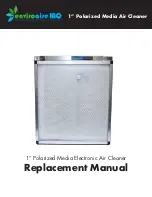
10
GB
D
F
I
NL
E
P
GR
RU
TR
2
Evacuation
Evacuate with the ball valve of the heat source unit closed and evacuate both
the connection piping and the indoor unit from the service port provided on the
ball valve of the heat source unit using a vacuum pump. (Always evacuate from
the service port of both the liquid pipe and the gas pipe.) After the vacuum
reaches 650 Pa [abs], continue evacuation for at least one hour or more.
* Never perform air purging using refrigerant.
[Fig. 8.3.2] (P.3)
A
System analyzer
B
Lo Knob
C
Hi Knob
D
Ball valve
E
Low press pipe
F
High press pipe
G
Service port
H
Three-way joint
I
Valve
J
Valve
K
Cylinder
L
Scale
M
Vacuum pump
Note:
•
Always add an appropriate amount of refrigerant. Also always seal the
system with liquid refrigerant. Too much or too little refrigerant will cause
trouble.
•
Use a gauge manifold, charging hose, and other parts for the refrigerant
indicated on the unit.
•
Use a graviometer. (One that can measure down to 0.1 kg.)
•
Use a vacuum pump with a reverse flow check valve. (For R407C models)
(Recommended vacuum gauge: ROBINAIR 14830A Thermistor Vacuum
Gauge)
Also use a vacuum gauge that reaches 0.5 Torr or greater after operating
for five minutes.
3
Refrigerant Charging (For R407C models)
Since the refrigerant used with the unit is nonazerotropic, it must be charged in
the liquid state. Consequently, when charging the unit with refrigerant from a
cylinder, if the cylinder does not have a syphon pipe, charge the liquid refriger-
ant by turning the cylinder upside-down as shown below. If the cylinder has a
syphon pipe like that shown in the figure at the right, the liquid refrigerant can
be charged with the cylinder standing upright. Therefore, give careful attention
to the cylinder specifications. If the unit should be charged with gas refrigerant,
replace all the refrigerant with new refrigerant. Do not use the refrigerant re-
maining in the cylinder.
[Fig. 8.3.3] (P.3)
8.4. Thermal insulation of refrigerant piping
Be sure to give insulation work to refrigerant piping by covering liquid pipe and gas
pipe separately with enough thickness heat-resistant polyethylene, so that no gap
is observed in the joint between indoor unit and insulating material, and insulating
materials themselves. When insulation work is insufficient, there is a possibility of
condensation drip, etc. Pay special attention to insulation work to ceiling plenum.
[Fig. 8.4.1] (P.4)
A
Steel wire
B
Piping
C
Asphaltic oily mastic or asphalt
D
Heat insulation material A
E
Outer covering B
Glass fiber + Steel wire
Ad Heat - resistant polyethylene foam + Adhesive tape
Indoor
Vinyl tape
Floor exposed
Water-proof hemp cloth + Bronze asphalt
Heat source
Water-proof hemp cloth + Zinc plate + Oily
paint
Note:
•
When using polyethylene cover as covering material, asphalt roofing shall
not be required.
•
No heat insulation must be provided for electric wires.
[Fig. 8.4.2] (P.4)
A
Liquid pipe
B
Gas pipe
C
Electric wire
D
Finishing tape
E
Insulater
[Fig. 8.4.3] (P.4)
Penetrations
[Fig. 8.4.4] (P.4)
<A> Inner wall (concealed)
<B> Outer wall
<C> Outer wall (exposed)
<D> Floor (fireproofing)
<E> Roof pipe shaft
<F> Penetrating portion on fire limit and boundary wall
A
Sleeve
B
Heat insulating material
C
Lagging
D
Caulking material
E
Band
F
Waterproofing laye
G
Sleeve with edge
H
Lagging material
I
Mortar or other incombustible caulking
J
Incombustible heat insulation material
When filling a gap with mortar, cover the penetration part with steel plate so that
the insulation material will not be caved in. For this part, use incombustible materi-
als for both insulation and covering. (Vinyl covering should not be used.)
Heat
insulation
material A
Outer
covering B
Restriction
• If a flammable gas or air (oxygen) is used as the pressurization
gas, it may catch fire or explode.
• Do not use a refrigerant other than that indicated on the unit.
• Sealing with gas from a cylinder will cause the composition of
the refrigerant in the cylinder to change. (For R407C models)
• Use a pressure gauge, charge box, and other parts especially for
R407C. (For R407C models)
• An electric leak detector for R22 cannot detect leaks of R407C.
• Do not use a haloid torch. (Leaks cannot be detected.)
Airtight test procedure
1. Nitrogen gas pressurization
(1) After pressurizing to the design pressure (2.94 MPa) using nitrogen gas, let stand for about
one day. If the pressure does not drop, airtightness is good.
However, if the pressure drops, since the leaking point is unknown, the following bubble test
may also be performed.
(2) After the pressurization described above, spray the flare connection parts, brazed parts, flanges,
and other parts that may leak with a bubbling agent (Kyuboflex, etc.) and visually check for
bubbles.
(3) After the airtight test, wipe off the bubbling agent.
2. Pressurization using refrigerant gas and nitrogen gas
(1) Pressurizing to a gas pressure of approximately 0.2 MPa, pressurize to the design pressure
(2.94 MPa) using nitrogen gas.
However, do not pressurize at one time. Stop during pressurization and check that the pres-
sure does not drop.
(2) Check for gas leaks by checking the flare connection parts, brazed parts, flanges, and other
parts which may leak using an R407C compatible electric leak detector.
(3) This test may be used together the with bubble type gas leak test.































